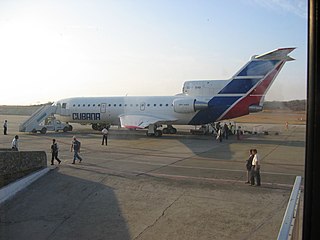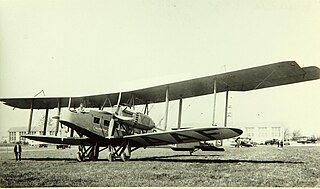
Handley Page Limited was a British aerospace manufacturer. Founded by Frederick Handley Page in 1909, it was the United Kingdom's first publicly traded aircraft manufacturing company. It went into voluntary liquidation and ceased to exist in 1970. The company, based at Radlett Aerodrome in Hertfordshire, was noted for its pioneering role in aviation history and for producing heavy bombers and large airliners.

The Handley Page HP.81 Hermes was a civilian airliner designed and produced by the British aircraft manufacturer Handley Page.

Antonio Maceo Airport is an international airport located in Santiago, Cuba.

The de Havilland DH.114 Heron is a small propeller-driven British airliner that first flew on 10 May 1950. It was a development of the twin-engine de Havilland Dove, with a stretched fuselage and two more engines. It was designed as a rugged, conventional low-wing monoplane with tricycle undercarriage that could be used on regional and commuter routes. A total of 149 were built; it was also exported to about 30 countries. Herons later formed the basis for various conversions, such as the Riley Turbo Skyliner and the Saunders ST-27 and ST-28.

The Fairchild F-27 and Fairchild Hiller FH-227 were versions of the Fokker F27 Friendship twin-engined, turboprop, passenger aircraft manufactured under license by Fairchild Hiller in the United States. The Fairchild F-27 was similar to the standard Fokker F27, while the FH-227 was an independently developed, stretched version.
Aerosucre S.A. is a cargo airline based in Bogotá, Colombia. It began operation in 1969 and operates scheduled international and domestic cargo services throughout Latin America and the Caribbean. Its home base is El Dorado International Airport, Bogotá. Aerosucre has been involved in a number of accidents and incidents during its lifetime, and more recently, internet videos have emerged showcasing reckless behavior by its pilots.

Rio-Sul Serviços Aéreos Regionais S/A was a regional airline headquartered in Rio de Janeiro, Brazil, operating scheduled services to southern Brazil. Its main base was São Paulo–Congonhas Airport, with hubs at Porto Alegre Airport and Santos Dumont Airport.

Tripoli International Airport is a closed international airport built to serve Tripoli, the capital city of Libya. The airport is located in the area of Qasr bin Ghashir, 24 kilometres (15 mi) from central Tripoli. It used to be the hub for Libyan Airlines, Afriqiyah Airways, and Buraq Air.

In aviation, a water landing is, in the broadest sense, an aircraft landing on a body of water. Seaplanes, such as floatplanes and flying boats, land on water as a normal operation. Ditching is a controlled emergency landing on the water surface in an aircraft not designed for the purpose, a very rare occurrence. Controlled flight into the surface and uncontrolled flight ending in a body of water are generally not considered water landings or ditching.

The Handley Page W.8, W.9 and W.10 were British two- and three-engine medium-range biplane airliners designed and built by Handley Page.

As of October November 2024, a total of 64 Boeing 747 aircraft, or just above 4% of the total number of 747s built, first flown commercially in 1970, have been involved in accidents and incidents resulting in a hull loss, meaning that the aircraft was either destroyed or damaged beyond economical repair. Of the 64 Boeing 747 aircraft losses, 32 resulted in no loss of life; in one, a hostage was murdered; and in one, a terrorist died.

Jersey Airlines was an early post-World War II private, independent British airline formed in 1948. In 1952, the airline operated its first scheduled service. Four years later, British European Airways (BEA) took a 25% minority stake in Jersey Airlines and made it an "associate". In June 1958, a Jersey Airlines de Havilland Heron became the first commercial airliner to arrive at the newly reconstructed Gatwick Airport. In 1960, Jersey Airlines ordered four state-of-the-art Handley Page Dart Herald 200 series turboprops. By 1962, BEA had sold its 25% minority holding in Jersey Airlines. The same year, Jersey Airlines became part of the British United Airways (BUA) group of companies. In August 1963, Jersey Airlines changed its trading name to British United (C.I.) Airways. Following the BUA group's 1967/8 reorganisation, BUA (C.I.) was absorbed into British United Island Airways (BUIA) in November 1968.

The 1920 Handley Page O/400 crash occurred on 14 December 1920 when a Handley Page Transport Handley Page O/400 on a scheduled passenger flight from London to Paris with two crew and six passengers crashed at Golders Green in North London after take-off from Cricklewood Aerodrome. The crew of two and two passengers were killed in the first fatal accident for the airline since the service had started in December 1919. It was reported as the first recorded airliner crash in history, but a larger airliner had crashed the previous year.
In aeronautics, loss of control (LOC) is the unintended departure of an aircraft from controlled flight and is a significant factor in several aviation accidents worldwide. In 2015 it was the leading cause of general aviation accidents. Loss of control may be the result of mechanical failure, external disturbances, aircraft upset conditions, or inappropriate crew actions or responses.
Herbert G Brackley was a pioneer of civil aviation during the first half of the twentieth century.

Lancashire Aircraft Corporation was a major British charter airline after World War II. Its founding father was Eric Rylands. It played an important role in the Berlin Airlift. It also flew scheduled routes and was important in the development of Coach-air services, leading to the founding of Skyways Coach Air and the start of the Inclusive Tour (IT) industry. Its major subsidiary, Samlesbury Engineering, supported its operations and converted many military aircraft for commercial use, also founding Lancashire Aircraft Company.

The 1922 Beijing-Han Airlines crash occurred when a Handley Page O/7 on a tour flight crashed during landing at Beijing Nanyuan Airport in 1922. It was China's first fatal commercial passenger aircraft accident.













